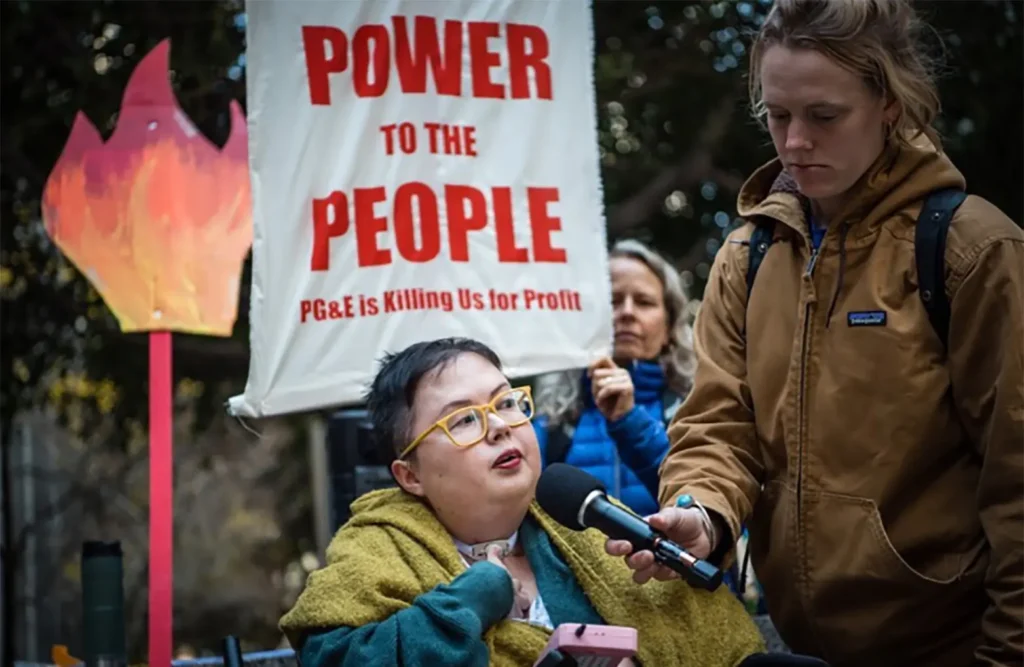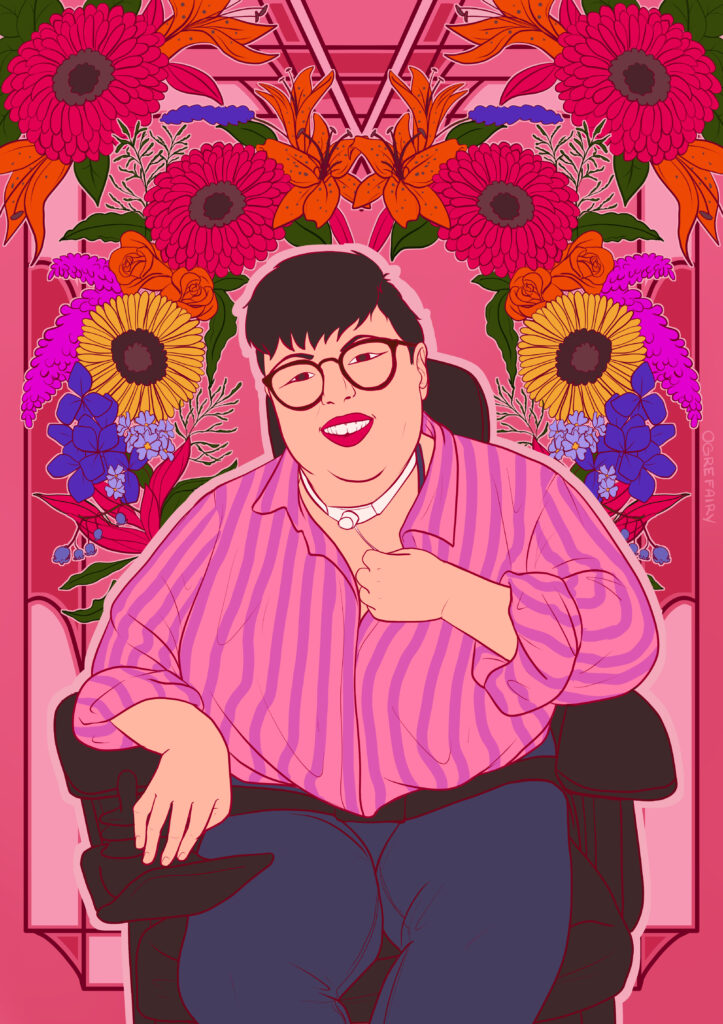
Stacey Park Milbern at a protest. There is a sign behind her that says “POWER TO THE PEOPLE, PG&E is Killing Us for Profit”, with a papercraft fire next to the sign. Stacey is speaking into a microphone.
On August 13 at 6:00 EDT, the National Museum of American History will host an event celebrating the life and legacy of Stacey Park Milbern and unveiling the quarter created in Stacey’s honor. AAPD is proud to be a sponsoring partner of the event. This program will be livestreamed here or you can register for free in-person tickets at this link. Both the in-person event and livestream will feature American Sign Language interpretation and real-time captioning.
As this exciting event grows closer, AAPD is sharing content about Stacey’s work, life, and love for community. In 2022, AAPD worked with Google to create this interactive page about Stacey’s life and legacy, using Stacey’s own words and writing. The text below is adapted from AAPD’s Google Arts and Culture online exhibit.
Stacey Park Milbern was a queer disabled woman of color and an activist, writer, speaker, and movement organizer who helped strengthen and lead the modern Disability Justice movement.
Stacey organized for people with disabilities and low-income people of color up until the time of her death. In response to power shut-offs by PG&E power company in 2019, Stacey worked in coalition and solidarity with other disabled people, older adults, and fat and queer people to organize a campaign called Power to Live. She sourced generators, ice, and medication and fought for the right to be rescued.
Stacey then became an Impact Producer for the award-winning documentary Crip Camp, and in the early weeks of the coronavirus pandemic, focused on mutual aid and support by and for disabled, queer Black Indigenous Disabled people of color. She created coronavirus kits with homemade hand sanitizer for people living in encampments and set up mutual aid networks through Disability Justice Culture Club, which she helped found. Her work at the beginning of the pandemic and work throughout so much of her life was grounded in the principles of disability justice.
Disability Justice is a framework that examines disability and ableism as it relates to other forms of oppression and identity. Disability Justice centers the experiences and leadership of disabled people of color, women, queer, trans, and gender nonconforming individuals.
Describing the importance of this work just a few weeks before her death, Stacey told Bay Area news outlet KQED: “It is such a painful experience to be left behind or disregarded. I have experienced feeling neglected by systems and society, and I don’t want that to continue. If I can use my skills developing care networks to keep someone a little more safe, it was all worth it.”
Stacey’s organizing skills and drive toward community care began from an early age. As a teenager, she described hearing disability rights icon Judy Heumann speak at a conference, and having an epiphany moment: In an interview for the Disability Visibility Project, Stacey said, “I was like, holy crap, I’ve been working so hard my whole life to be like everyone else and I’m still different. And I can’t figure out why. And now it all makes sense. I have a disability!”
It didn’t take long for Stacey to embody this newfound identity and start making positive change. As a teenager, Stacey co-founded the North Carolina Youth Leadership Forum for young people with disabilities and was appointed by the Governor of North Carolina to the North Carolina Statewide Independent Living Council. In college, she was involved in the National Youth Leadership Network, and in the summer of 2007, she participated in the AAPD Summer Internship Program, interning for Senator Tom Harkin’s Disability Counsel, Lee Perselay, on the Senate Health, Education, Labor, and Pension (HELP) Committee.
In the journals each intern was required to submit, Stacey describes important Washington events, exciting conferences and programs, and interactions with Senator Harkin and other elected and movement leaders. But these details are not the center of her writings. Stacey’s journals depict a young person concerned less with her own proximity to power than with doing everything she could to ensure her fellows have access to community and belonging.
Writing about attending the National Council on Independent Living (NCIL) conference that summer, and finding an opportunity to plug a friend into involvement in the conference: “I think it really proves that one person, one instance, one conference can make a life-changing difference…I think we all have the power to help in each person’s empowerment. Empowerment truly has to come from the individual but we have the responsibility to take part in it. This week made me so happy.”
Stacey’s belief that we all have a responsibility to participate in one another’s liberation and well-being is part of the larger Disability Justice tenet of interdependence: We are all dependent on one another, no one is truly independent, and none of us have to go it alone. This concept is called “interdependence.” Stacey believed in interdependence and that we all have a sacred obligation to one another.
Stacey advanced the Disability Justice movement. She spoke out often about what it means to be a disabled queer woman of color, about police brutality against disabled people, about racial segregation and criminalization in special education programs in schools, about access to health care, about the difficulties of obtaining adequate and high-quality personal attendant services and care, and more.
Stacey also practiced disability pride. Stacey authored a widely-read blog Crip Chick through which she “scribbled herself into existence,” organized protests of the Jerry Lewis Telethon, mobilized the ADA Generation to defend one another against injustice, and developed an online community through which she and her cripfam supported each other’s agency and pride. When thinking about disability pride, Stacey wrote:
“A lot of times disability pride gets watered down into this happy-go-lucky accepting who you are/gaining self esteem bit. Though self-acceptance is so important, nondisabled people understanding disability pride in this way disregards the power of disability pride and critiques of ableism. Disability itself redefines normal, redefines what is considered dependence, and if included in social justice analyses, can be extremely useful in understanding how the world works. Living and practicing disability pride is so much bigger than self acceptance.”
Beyond understanding the issues deeply and leading from a place of intersectionality, Stacey’s love for and commitment to the liberation of queer, trans, and BIPOC disabled people was unwavering.
Stacey wrote and thought a lot about disabled ancestry. One of her final publications was an essay for the Disability Visibility Project in 2019, called “On The Ancestral Plane: Crip Hand-Me-Downs and the Legacy of Our Movements.” The essay can also be found in Disability Visibility: First-Person Stories from the Twenty-First Century, an anthology edited by Alice Wong (Vintage Books, 2020).
“I do not know a lot about spirituality or what happens when we die, but my crip queer Korean life makes me believe that our earthly bodymind is but a fraction, and not considering our ancestors is electing to see only a glimpse of who we are…
Ancestorship, like love, is expansive and breaks manmade boundaries cast upon it, like the nuclear family model or artificial nation state borders.
My ancestors are disabled people who lived looking out of institution windows wanting so much more for themselves. It’s because of them that I know that, in reflecting on what is a “good” life, an opportunity to contribute is as important as receiving supports one needs.
My ancestors are people torn apart from loves by war and displacement. It’s because of them I know the power of building home with whatever you have, wherever you are, whoever you are with.
My ancestors are queers who lived in the American South. It’s because of them I understand the importance of relationships, place and living life big, even if it is dangerous. All of my ancestors know longing. Longing is often our connecting place.”

Portrait by Michaela Oteri of Stacey Park Milbern wearing a pink shirt vibrant red lipstick. She is smiling. Flowers of multiple types and colors are behind her.
As we ourselves long for a world where it is safer for disabled people to grow, change, and be vulnerable, we honor Stacey’s memory, legacy, all she taught us, and all she continues to teach us, as an ancestor.
Read a full syllabus of Stacey’s work by Leah Lakshmi Piepzna-Samarasinha and Alice Wong.
